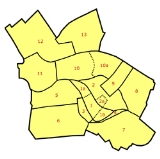
Cölln
Encyclopedia
| Coat of Arms | Map |
|---|---|
| |
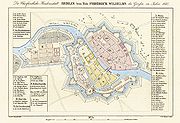 Central Berlin in 1688 with Cölln (yellow) |
| Basic Information | |
| City City A city is a relatively large and permanent settlement. Although there is no agreement on how a city is distinguished from a town within general English language meanings, many cities have a particular administrative, legal, or historical status based on local law.For example, in the U.S... : |
Berlin Berlin Berlin is the capital city of Germany and is one of the 16 states of Germany. With a population of 3.45 million people, Berlin is Germany's largest city. It is the second most populous city proper and the seventh most populous urban area in the European Union... |
| Borough Boroughs and localities of Berlin Berlin is both a city and one of Germany’s federal states. It is made up of twelve boroughs , each with its own borough government, though all boroughs are subject to Berlin’s city and state government.-History:Each borough is made up of several officially recognized localities... : |
Mitte Mitte Mitte is the first and most central borough of Berlin. It was created in Berlin's 2001 administrative reform by the merger of the former districts of Mitte proper, Tiergarten and Wedding; the resulting borough retained the name Mitte. It is one of the two boroughs which comprises former West and... |
| Locality Boroughs and localities of Berlin Berlin is both a city and one of Germany’s federal states. It is made up of twelve boroughs , each with its own borough government, though all boroughs are subject to Berlin’s city and state government.-History:Each borough is made up of several officially recognized localities... : |
Mitte Mitte (locality) Mitte is a central locality of Berlin in the homonymous district of Mitte. Until 2001 it was itself an autonomous district.... |
| Area Area Area is a quantity that expresses the extent of a two-dimensional surface or shape in the plane. Area can be understood as the amount of material with a given thickness that would be necessary to fashion a model of the shape, or the amount of paint necessary to cover the surface with a single coat... : |
? |
| Population Population A population is all the organisms that both belong to the same group or species and live in the same geographical area. The area that is used to define a sexual population is such that inter-breeding is possible between any pair within the area and more probable than cross-breeding with individuals... : |
? |
| Coordinates Coordinate system In geometry, a coordinate system is a system which uses one or more numbers, or coordinates, to uniquely determine the position of a point or other geometric element. The order of the coordinates is significant and they are sometimes identified by their position in an ordered tuple and sometimes by... : |
52°31′02"N 13°24′10"E |
| Elevation Elevation The elevation of a geographic location is its height above a fixed reference point, most commonly a reference geoid, a mathematical model of the Earth's sea level as an equipotential gravitational surface .... : |
34 m (111 ft) above sea level Sea level Mean sea level is a measure of the average height of the ocean's surface ; used as a standard in reckoning land elevation... |

Berlin
Berlin is the capital city of Germany and is one of the 16 states of Germany. With a population of 3.45 million people, Berlin is Germany's largest city. It is the second most populous city proper and the seventh most populous urban area in the European Union...
(Altberlin
Alt-Berlin
Alt-Berlin , also named Altberlin, is a neighbourhood , situated in the Berliner locality of Mitte, part of the homonymous borough. In the 13th century it was the sister town of the old Cölln, located on the northern Spree Island in the Margraviate of Brandenburg...
), located on the southern Spree
Spree
The Spree is a river that flows through the Saxony, Brandenburg and Berlin states of Germany, and in the Ústí nad Labem region of the Czech Republic...
Island in the Margraviate of Brandenburg
Margraviate of Brandenburg
The Margraviate of Brandenburg was a major principality of the Holy Roman Empire from 1157 to 1806. Also known as the March of Brandenburg , it played a pivotal role in the history of Germany and Central Europe....
. Today the island is located in the historic core of the central Mitte
Mitte
Mitte is the first and most central borough of Berlin. It was created in Berlin's 2001 administrative reform by the merger of the former districts of Mitte proper, Tiergarten and Wedding; the resulting borough retained the name Mitte. It is one of the two boroughs which comprises former West and...
locality of modern Berlin. Its northern peak is known as Museum Island
Museum Island
Museum Island is the name of the northern half of an island in the Spree river in the central Mitte district of Berlin, Germany, the site of the old city of Cölln...
, while the part south of Gertraudenstraße is called Fischerinsel (Fishermen's Island).
History
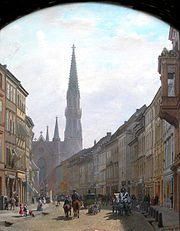
Priesthood (Catholic Church)
The ministerial orders of the Catholic Church include the orders of bishops, deacons and presbyters, which in Latin is sacerdos. The ordained priesthood and common priesthood are different in function and essence....
Symeon of Cölln's Saint Peter
Saint Peter
Saint Peter or Simon Peter was an early Christian leader, who is featured prominently in the New Testament Gospels and the Acts of the Apostles. The son of John or of Jonah and from the village of Bethsaida in the province of Galilee, his brother Andrew was also an apostle...
's Church as a witness. This date is commonly regarded as the origin of Berlin, though Altberlin on the eastern bank of the Spree river was not mentioned before 1244 and part of nowadays Greater Berlin
Greater Berlin Act
The Greater Berlin Act , in full the Law Regarding the Reconstruction of the New Local Authority of Berlin , was a law passed by the Prussian government in 1920 that greatly expanded the size of the German capital of Berlin.-History:...
like Spandau
Spandau
Spandau is the fifth of the twelve boroughs of Berlin. It is the fourth largest and westernmost borough, situated at the confluence of the Havel and Spree rivers and along the western bank of the Havel, but the least populated.-Overview:...
and Köpenick
Köpenick
Köpenick is a historic town and locality that is situated at the confluence of the rivers Dahme and Spree in the south-east of the German capital city of Berlin. It was formerly known as Copanic and then Cöpenick, only officially adopting the current spelling in 1931...
are even older.
Cölln and Altberlin were separated only by the river Spree, linked by the Mühlendamm causeway
Causeway
In modern usage, a causeway is a road or railway elevated, usually across a broad body of water or wetland.- Etymology :When first used, the word appeared in a form such as “causey way” making clear its derivation from the earlier form “causey”. This word seems to have come from the same source by...
, hence there was a close connection right from the start. Since the trade route
Trade route
A trade route is a logistical network identified as a series of pathways and stoppages used for the commercial transport of cargo. Allowing goods to reach distant markets, a single trade route contains long distance arteries which may further be connected to several smaller networks of commercial...
from Magdeburg
Magdeburg
Magdeburg , is the largest city and the capital city of the Bundesland of Saxony-Anhalt, Germany. Magdeburg is situated on the Elbe River and was one of the most important medieval cities of Europe....
to Frankfurt (Oder)
Frankfurt (Oder)
Frankfurt is a town in Brandenburg, Germany, located on the Oder River, on the German-Polish border directly opposite the town of Słubice which was a part of Frankfurt until 1945. At the end of the 1980s it reached a population peak with more than 87,000 inhabitants...
crosses the twin town and the inland water-transportation routes also passed through it, Cölln-Berlin quickly came to prosperity. A second crossing, the Lange Brücke (Long Bridge), today the Rathausbrücke (Town Hall Bridge) was erected across the Spree in 1307 with a common town hall in the middle of it.
The common policy of Berlin and Cölln led 1307 to a first alliance with other towns (Brandenburg an der Havel
Brandenburg (town)
Brandenburg an der Havel is a town in the state of Brandenburg, Germany, with a population of 71,778 . It is located on the banks of the River Havel. The town of Brandenburg, which is almost as widely known as the state of Brandenburg, provided the name for the medieval Bishopric of Brandenburg,...
, Frankfurt (Oder)
Frankfurt (Oder)
Frankfurt is a town in Brandenburg, Germany, located on the Oder River, on the German-Polish border directly opposite the town of Słubice which was a part of Frankfurt until 1945. At the end of the 1980s it reached a population peak with more than 87,000 inhabitants...
and Salzwedel
Salzwedel
Salzwedel of Altmarkkreis Salzwedel, and has a population of approximately 21,500. Salzwedel is located on the German Framework Road.-Geography:...
) in the March to defend their rights against the sovereign. The Elector
Prince-elector
The Prince-electors of the Holy Roman Empire were the members of the electoral college of the Holy Roman Empire, having the function of electing the Roman king or, from the middle of the 16th century onwards, directly the Holy Roman Emperor.The heir-apparent to a prince-elector was known as an...
Frederick II Irontooth
Frederick II, Elector of Brandenburg
Frederick II of Brandenburg , nicknamed "the Iron" and sometimes "Irontooth" , was a Prince-elector of the Margraviate of Brandenburg from 1440 until his abdication in 1470, and was a member of the House of Hohenzollern.-Biography:Frederick II was born in Tangermünde to Frederick I, Brandenburg's...
of Brandenburg ended the autonomy of Cölln/Berlin and declared the twin town to his residence in 1451. In 1710 the twin cities Cölln and old Berlin merged by the order of King Frederick I
Frederick I of Prussia
Frederick I , of the Hohenzollern dynasty, was Elector of Brandenburg and Duke of Prussia in personal union . The latter function he upgraded to royalty, becoming the first King in Prussia . From 1707 he was in personal union the sovereign prince of the Principality of Neuchâtel...
to form the capital of Prussia
Kingdom of Prussia
The Kingdom of Prussia was a German kingdom from 1701 to 1918. Until the defeat of Germany in World War I, it comprised almost two-thirds of the area of the German Empire...
. As Altberlin was twice as big as Cölln at that time, the merged city was named Berlin.
The name of Cölln survives in the Berlin southeastern borough of Neukölln
Neukölln
Neukölln is the eighth borough of Berlin, located in the southeastern part of the city and was part of the former American sector under the Four-Power occupation of the city...
(New Cölln). Originally a southern extension of Cölln was called Neukölln am Wasser, as well as the "Köllnischer Park" and the street "Am Köllnischen Park" are both located in the adjacent area. An outdoor enclosure, situated directly in the park, is home of three brown bears (the bear is the heraldic animal of the City of Berlin), representing the cradle of the city.
Places of interest
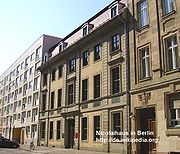
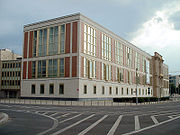
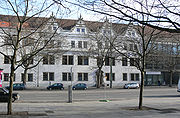
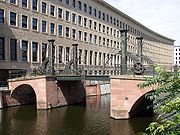
Battle of Berlin
The Battle of Berlin, designated the Berlin Strategic Offensive Operation by the Soviet Union, was the final major offensive of the European Theatre of World War II....
in 1945. It was finally demolished in 1964. The church bore its name because many of Cölln's inhabitants depended on fishing
Fishing
Fishing is the activity of trying to catch wild fish. Fish are normally caught in the wild. Techniques for catching fish include hand gathering, spearing, netting, angling and trapping....
. Today only the name of the Petriplatz square marks the site. From here the Brüderstraße runs north, named after the brothers of a former Dominican
Dominican Order
The Order of Preachers , after the 15th century more commonly known as the Dominican Order or Dominicans, is a Catholic religious order founded by Saint Dominic and approved by Pope Honorius III on 22 December 1216 in France...
monastery established in 1297. Though most of the neighbourhood was destroyed, a few Baroque
Baroque architecture
Baroque architecture is a term used to describe the building style of the Baroque era, begun in late sixteenth century Italy, that took the Roman vocabulary of Renaissance architecture and used it in a new rhetorical and theatrical fashion, often to express the triumph of the Catholic Church and...
houses remained:
The bookseller Christoph Friedrich Nicolai
Christoph Friedrich Nicolai
Christoph Friedrich Nicolai was a German writer and bookseller.Nicolai was born in Berlin, where his father, Christoph Gottlieb Nicolai , was the founder of the famous Nicolaische Buchhandlung...
lived on Brüderstraße 13 from 1787 until his death in 1811. Today the house is still called Nicolaihaus, it was erected about 1670 and had belonged to the merchant
Merchant
A merchant is a businessperson who trades in commodities that were produced by others, in order to earn a profit.Merchants can be one of two types:# A wholesale merchant operates in the chain between producer and retail merchant...
Johann Ernst Gotzkowsky
Johann Ernst Gotzkowsky
Johann Ernst Gotzkowsky was a Prussian merchant with a successful trade in trinkets, silk, taft and porcelain. A relief on Meissen porcelain introduced in 1740s was named after him. Moreover he acted as a diplomat and art dealer...
from 1747 to 1773. Nicolai had it remodeled by the mason
Masonry
Masonry is the building of structures from individual units laid in and bound together by mortar; the term masonry can also refer to the units themselves. The common materials of masonry construction are brick, stone, marble, granite, travertine, limestone; concrete block, glass block, stucco, and...
and composer
Composer
A composer is a person who creates music, either by musical notation or oral tradition, for interpretation and performance, or through direct manipulation of sonic material through electronic media...
Carl Friedrich Zelter
Carl Friedrich Zelter
Carl Friedrich Zelter was a German composer, conductor and teacher of music.Zelter became friendly with Johann Wolfgang von Goethe, and his works include settings of Goethe's poems...
, making it a meeting-point of intellectuals influenced by the Age of Enlightenment
Age of Enlightenment
The Age of Enlightenment was an elite cultural movement of intellectuals in 18th century Europe that sought to mobilize the power of reason in order to reform society and advance knowledge. It promoted intellectual interchange and opposed intolerance and abuses in church and state...
(Aufklärung) and Romanticism
Romanticism
Romanticism was an artistic, literary and intellectual movement that originated in the second half of the 18th century in Europe, and gained strength in reaction to the Industrial Revolution...
movement. In 1786 Honoré Mirabeau
Honoré Gabriel Riqueti, comte de Mirabeau
Honoré Gabriel Riqueti, comte de Mirabeau was a French revolutionary, as well as a writer, diplomat, freemason, journalist and French politician at the same time. He was a popular orator and statesman. During the French Revolution, he was a moderate, favoring a constitutional monarchy built on...
stayed here on his first trip to Berlin and so did the architect
Architect
An architect is a person trained in the planning, design and oversight of the construction of buildings. To practice architecture means to offer or render services in connection with the design and construction of a building, or group of buildings and the space within the site surrounding the...
Karl Friedrich Schinkel
Karl Friedrich Schinkel
Karl Friedrich Schinkel was a Prussian architect, city planner, and painter who also designed furniture and stage sets. Schinkel was one of the most prominent architects of Germany and designed both neoclassical and neogothic buildings.-Biography:Schinkel was born in Neuruppin, Margraviate of...
, the sculptor Johann Gottfried Schadow
Johann Gottfried Schadow
Johann Gottfried Schadow was a German sculptor.-Biography:Schadow was born in Berlin, where his father was a poor tailor....
, the printmaker Daniel Chodowiecki
Daniel Chodowiecki
Daniel Niklaus Chodowiecki was a Polish - German painter and printmaker with Huguenot ancestry, who is most famous as an etcher...
as well as the poet
Poet
A poet is a person who writes poetry. A poet's work can be literal, meaning that his work is derived from a specific event, or metaphorical, meaning that his work can take on many meanings and forms. Poets have existed since antiquity, in nearly all languages, and have produced works that vary...
Theodor Körner
Theodor Körner (author)
Karl Theodor Körner was a German poet and soldier. After some time in Vienna, where he wrote some light comedies and other works, he became a soldier and joined the German uprising against Napoleon...
in 1811. Körner's father Christian Gottfried Körner
Christian Gottfried Körner
Christian Gottfried Körner was a German jurist. His home was a literary and musical salon, and he was a friend of Friedrich Schiller.-Biography:...
lived here as a Prussia
Kingdom of Prussia
The Kingdom of Prussia was a German kingdom from 1701 to 1918. Until the defeat of Germany in World War I, it comprised almost two-thirds of the area of the German Empire...
n Privy Councillor
Privy council
A privy council is a body that advises the head of state of a nation, typically, but not always, in the context of a monarchic government. The word "privy" means "private" or "secret"; thus, a privy council was originally a committee of the monarch's closest advisors to give confidential advice on...
from 1815 to 1828.
On Brüderstraße 10 stands the Galgenhaus (Gallows
Gallows
A gallows is a frame, typically wooden, used for execution by hanging, or by means to torture before execution, as was used when being hanged, drawn and quartered...
House), built about 1688. According to legend, a maid
Maid
A maidservant or in current usage housemaid or maid is a female employed in domestic service.-Description:Once part of an elaborate hierarchy in great houses, today a single maid may be the only domestic worker that upper and even middle-income households can afford, as was historically the case...
servant was hanged right in front of the house in 1735, being falsely accused of stealing a silver spoon. From 1742 on the building belonged to the early statistician
Statistics
Statistics is the study of the collection, organization, analysis, and interpretation of data. It deals with all aspects of this, including the planning of data collection in terms of the design of surveys and experiments....
Johann Peter Süßmilch, at this time provost
Provost (religion)
A provost is a senior official in a number of Christian churches.-Historical Development:The word praepositus was originally applied to any ecclesiastical ruler or dignitary...
of the Saint Peter's Church. The neighbouring building, built in 1905, is home of the Berlin representation of the Federal State
States of Germany
Germany is made up of sixteen which are partly sovereign constituent states of the Federal Republic of Germany. Land literally translates as "country", and constitutionally speaking, they are constituent countries...
of Saxony
Saxony
The Free State of Saxony is a landlocked state of Germany, contingent with Brandenburg, Saxony Anhalt, Thuringia, Bavaria, the Czech Republic and Poland. It is the tenth-largest German state in area, with of Germany's sixteen states....
.
Nearby the Sperlingsgasse branches off, where the novelist Wilhelm Raabe
Wilhelm Raabe
Wilhelm Raabe , German novelist, whose early works were published under the pseudonym of Jakob Corvinus, was born in Eschershausen ....
lived from 1854 to 1856 and published his popular work Die Chronik der Sperlingsgasse. The small alley, at this time the Spreegasse, was renamed in 1931 on occasion of the author's hundredth anniversary. All former buildings on this street were demolished about 1960.
The northern part of the Brüderstraße today is covered by the 1964 building of the former Staatsrat
Staatsrat
In the German Democratic Republic , the State Council was the collective head of state from 1960 to 1990.-Origins:...
of the German Democratic Republic
German Democratic Republic
The German Democratic Republic , informally called East Germany by West Germany and other countries, was a socialist state established in 1949 in the Soviet zone of occupied Germany, including East Berlin of the Allied-occupied capital city...
. The façade
Facade
A facade or façade is generally one exterior side of a building, usually, but not always, the front. The word comes from the French language, literally meaning "frontage" or "face"....
at the Schloßplatz
Schloßplatz
Schloßplatz is a common name for squares in many German-speaking countries. Cities which have a Schloßplatz include Berlin, Frankfurt am Main, Stuttgart and Dresden.-Overview:...
square includes the preserved portal
Portal (architecture)
Portal is a general term describing an opening in the walls of a building, gate or fortification, and especially a grand entrance to an important structure. Doors, metal gates or portcullis in the opening can be used to control entry or exit. The surface surrounding the opening may be made of...
No. IV of the demolished Hohenzollern
House of Hohenzollern
The House of Hohenzollern is a noble family and royal dynasty of electors, kings and emperors of Prussia, Germany and Romania. It originated in the area around the town of Hechingen in Swabia during the 11th century. They took their name from their ancestral home, the Burg Hohenzollern castle near...
City Palace, where Karl Liebknecht
Karl Liebknecht
was a German socialist and a co-founder with Rosa Luxemburg of the Spartacist League and the Communist Party of Germany. He is best known for his opposition to World War I in the Reichstag and his role in the Spartacist uprising of 1919...
on November 9, 1918 declared a free socialist republic of Germany. After German reunification
German reunification
German reunification was the process in 1990 in which the German Democratic Republic joined the Federal Republic of Germany , and when Berlin reunited into a single city, as provided by its then Grundgesetz constitution Article 23. The start of this process is commonly referred by Germans as die...
the building served as the Chancellery
German Chancellery
The German Chancellery is a federal agency serving the executive office of the Chancellor, the head of the German federal government. The chief of the Chancellery holds the rank of either a Secretary of State or a Federal Minister ...
from 1999 to 2001. Today it houses the European School of Management and Technology
European School of Management and Technology
ESMT European School of Management and Technology is a private university located in Berlin, Germany.ESMT European School of Management and Technology is an international non-profit business school based in Berlin with an additional location in Schloss Gracht near Cologne. The School was founded by...
and the Hertie School of Governance
Hertie School of Governance
The Hertie School of Governance is a private university in Berlin, in the historic Quartier 110 of Friedrichstraße. The school is regarded as one of the leading policy institutes in Europe...
. The area north of the Schloßplatz is the site of the historic City Palace and still of the demolition
Demolition
Demolition is the tearing-down of buildings and other structures, the opposite of construction. Demolition contrasts with deconstruction, which involves taking a building apart while carefully preserving valuable elements for re-use....
of the 1976 Palast der Republik
Palast der Republik
The Palace of the Republic in Berlin was the seat of the parliament of the German Democratic Republic, the People's Chamber, and also served various cultural purposes...
. According to a 2002 resolution by the federal Bundestag
Bundestag
The Bundestag is a federal legislative body in Germany. In practice Germany is governed by a bicameral legislature, of which the Bundestag serves as the lower house and the Bundesrat the upper house. The Bundestag is established by the German Basic Law of 1949, as the successor to the earlier...
parliament the City Palace should be rebuilt.
Parallel to the Brüderstraße runs the Breite Straße (Broad Street), Cölln's main street. At the corner of the Schloßplatz are the buildings of the Old and the New Marstall riding stable
Stable
A stable is a building in which livestock, especially horses, are kept. It most commonly means a building that is divided into separate stalls for individual animals...
s of the Electors of Brandenburg, built in 1670 and 1901. Today the New Marstall is a seat of the Hanns Eisler Conservatory
Hochschule für Musik Hanns Eisler
The " in Berlin, Germany is one of the leading music conservatories in Europe. It was established in East Berlin in 1950 as the ' because the older was in West Berlin...
. On neighbouring Breite Straße 35 is the late Renaissance
Renaissance architecture
Renaissance architecture is the architecture of the period between the early 15th and early 17th centuries in different regions of Europe, demonstrating a conscious revival and development of certain elements of ancient Greek and Roman thought and material culture. Stylistically, Renaissance...
Ribbeckhaus from 1624, one of Berlin's oldest preserved residential buildings, which since 1920 houses the Central and Regional Library
Public library
A public library is a library that is accessible by the public and is generally funded from public sources and operated by civil servants. There are five fundamental characteristics shared by public libraries...
.
Three historic bridges connect Cölln with the 17th century extension of Friedrichswerder on the western bank of the Spree river: the Schleusenbrücke (Sluice Bridge) at the Schloßplatz, a steel
Steel
Steel is an alloy that consists mostly of iron and has a carbon content between 0.2% and 2.1% by weight, depending on the grade. Carbon is the most common alloying material for iron, but various other alloying elements are used, such as manganese, chromium, vanadium, and tungsten...
construction erected in 1916, the Gertraudenbrücke with the statue of Saint Gertrude of Nivelles
Gertrude of Nivelles
Saint Gertrude of Nivelles was abbess of the Benedictine monastery of Nivelles, in present-day Belgium.She was a daughter of Pepin I of Landen and Saint Itta, and a younger sister of Saint Begga, Abbess of Andenne, Saint Bavo and Grimoald I.One day, when she was about ten years of age, her father...
by the sculptor Rudolf Siemering from 1896 and the small Jungfernbrücke (Virgin's Bridge) built in 1798, Berlin's oldest and the only bascule bridge
Bascule bridge
A bascule bridge is a moveable bridge with a counterweight that continuously balances the span, or "leaf," throughout the entire upward swing in providing clearance for boat traffic....
of the city.

